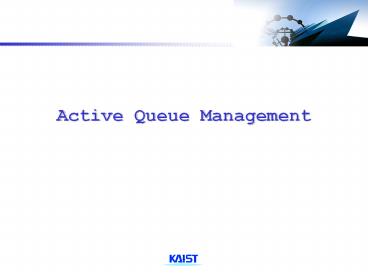Active Queue Management - PowerPoint PPT Presentation
1 / 12
Title:
Active Queue Management
Description:
Computer Network Lab. AQM's Advantages for Responsive Flows ... Computer Network Lab. Random Early Detection. An active queue management ... – PowerPoint PPT presentation
Number of Views:81
Avg rating:3.0/5.0
Title: Active Queue Management
1
Active Queue Management
2
Need for Active Queue Management
- Drawbacks of Drop tail
- Lock-out
- Full queue
- Long queueing delay
- Cannot permit the transmission of data in burst.
- Random drop or drop front solves the lock-out
problem. - Active queue management
- Drop packets before a queue becomes full
- Solution to the full queue problem
3
AQMs Advantages for Responsive Flows
- Reduce number of packets dropped in routers
- Permit packets in burst
- Avoid global synchronization
- Provide lower-delay interactive service
- By keeping the average queue size small
- Avoid lock-out behavior
- Ensuring that there will almost always be a
buffer available for an incoming packet.
4
Random Early Detection
- An active queue management
- Dropping packets randomly before the buffer is
full. - No burst drop
- Less queueing delay
- Fair packet drop
- Hard to configure parameters
RED Drop Function
Drop Prob.
1
P-max
Q_min
Q_max
Que. Length
5
Managing Aggressive Flows
- Three classes of flows
- TCP-compatible flows
- Behaving under congestion like a flow produced by
a conformant TCP - Claim no more bandwidth that a conformant TCP
running under comparable conditions - Unresponsive flows
- Flows that do not slow down when congestion
occurs - Flows that are responsive but are not
TCP-compatible - There should be a protect for the Internet from
the last two classes.
6
Recommendations on Queue Management from RFC2309
- Internet routers should implement some active
queue management mechanism to manage queue
lengths, reduce end-to-end latency, reduce packet
dropping and avoid lock-out phenomena within the
Internet. - It is urgent to begin or continue research,
engineering and measurement efforts contributing
to the design of mechanisms to deal with flows
that are unresponsive to congestion notification
or are responsive but more aggressive than TCP.
7
RED Performance Evaluations
8
RED Performance Evaluations
9
Discussion on RED Performance
- RED does not exhibit much better performance than
drop tail. - Drop tail is more aggressive than RED in the case
of UDP traffic. - RED parameters have a minor impact on the
performance with small buffer. - RED with large buffers can improve the system
performance but choosing good RED settings is not
straight forward. - For an incremental deployment, small buffers are
very sensitive for the end2end performance.
10
Topology
snk0
src0
src1
snk1
src2
snk2
r1
r0
src3
snk3
src4
snk4
11
Simulation with RED
- Queue set limit_ 50
- Queue/RED set thresh_ 20
- Queue/RED set maxthresh_ 40
- Queue/RED set linterm_ 10
- for set i 0 i lt 5 incr i
- ns duplex-link src(i) r0 10Mb 5ms DropTail
- ns duplex-link snk(i) r1 10Mb 5ms DropTail
- ns duplex-link r0 r1 1Mb 5ms RED
12
Average Sending and Drop Rates
- RED
- Average arrival rate
- flow 0 0.220667 Mbps
- flow 1 0.204933 Mbps
- flow 2 0.183600 Mbps
- flow 3 0.196000 Mbps
- flow 4 0.207467 Mbps
- Average drop rate
- flow 0 0.020544
- flow 1 0.024073
- flow 2 0.028322
- flow 3 0.025170
- flow 4 0.020566
Drop Tail Average arrival rate flow 0 0.216400
Mbps flow 1 0.190533 Mbps flow 2 0.208933
Mbps flow 3 0.205333 Mbps flow 4 0.184267
Mbps Average drop rate flow 0 0.015404 flow 1
0.017495 flow 2 0.015954 flow 3 0.016234 flow
4 0.015919































